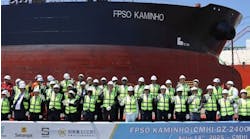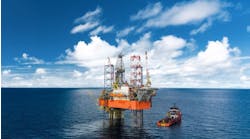Unidentified shallow gas in marine sediments can pose serious risks to field developments, potentially triggering blowouts during drilling, or disrupting conductor installation. Deepwater gas hydrates are another known, but hard to quantify, hazard to drilling and pipelaying.
French research institute Ifremer has recently completed a geotechnical study on Total’s behalf relating to suspect deepwater phenomena in the Gulf of Guinea. It is now seeking further sponsors for a new joint industry project (Total and BP have already committed) to address concerns generic to West Africa, but possibly relevant also to parts of Southeast Asia.
The completed study involved analysis of pockmarks on the seabed in the Gulf of Guinea, close to the route of planned pipeline and template installations. Total was concerned that these features may have been deformations caused by melting sub-surface hydrates. During 2003-04, Ifremer mounted geotechnical studies over the area, using its own vessel spread, which included towed seismic sources and deep-sea cone penetrometers. The data was then interpreted over a two-year period at Ifremer’s headquarters in Brest.
According to Group Director of Offshore Technology Lionel Lemoine, the results should give project planners greater confidence over placement of anchors for laybarges during work on the pipeline.
The newly proposed project, to research the acoustic properties and mechanical behavior of marine sediments partially saturated by gas, would be conducted jointly with Fugro France and Cermes.
Evidence suggests that the mechanical properties of gas-charged sediments are affected by volumes of free gas, but are insensitive to dissolved gas. Typically, pore water samplers are used to detect and quantify the amount of gas dissolved in pore water, but these instruments cannot quantify free gas. Fugro, however, has developed a pressure coring system, named Hyace, which could be adapted for use in geotechnical wireline deployments.
A soil’s compressive (P-wave) velocity is known to be highly sensitive to the presence of free gas. Ifremer’s studies in the hydrate-rich sediments offshore Africa included in situ P-wave measurements, and these established a good correlation between low Vp values and the presence of free gas, typically recording gas saturation values of around 20%. The research team concluded that gas detection in the sediments might be feasible by analysing mechanical, physical, and acoustic properties.
In soils experiencing low levels of gas saturation, fluid transfer applies more to bulk water than adsorbed water. The gas - bulk water interaction can be quantified in terms of the gas - water pressure difference (capillary pressure), and is known to influence the soils’ mechanical behavior.
Ifremer suspects this rule would apply also to gassier sediments, but there is no technology at present to measure these parameters in situ. However, research by Cermes has shown that correlations between capillary pressure and free gas content are obtainable using mercury intrusion porosimetry.
The proposed one-year JIP would involve a series of tests at Ifremer’s and Cermes’ laboratories in western France, with Fugro providing an advisory and reviewing role. Representative samples would be supplied by the project sponsors. The JIP partners have set three main goals:
1) To assess the impact of parameters such as degree of consolidation, microstructure, and mineralogy on the generation and development of gas in marine sediments from a discontinuous to a continuous gas phase. Triaxial laboratory tests would be mounted involving controlled gas exsolution.
2) To quantify the degree of gas saturation from knowledge of P- and S-wave measurements, using techniques such as mercury intrusion porosimetry. This would entail submitting samples to different effective stress states and degrees of gas saturation.
3) To identify the main parameters controlling the behavior of marine soils partly saturated by gas. In this case, samples with varying degrees of saturation would be submitted to various triaxial paths by independent control of gas and water pressures.
CP validation
Ifremer has worked for another consortium of operators, developing cathodic protection sensors (CPCs) for deep-sea structures. These were subsequently applied offshore Angola.
Now Ifremer is proposing a follow-up JIP with the Institut de la Corrosion in Brest, called ICP-DATA. This would supply cathodic protection designers with validated information on the actual environment where the structures will be deployed, one aim being to optimize the protection system’s efficiency.
Cathodic protection design involves wide-ranging calculations based on proposed materials, the surface area exposed to seawater, the marine environment (salinity, dissolved oxygen, temperature), and other factors. The normal design selection procedure applies data available in standards literature (i.e. EN 13174). However, where inaccurate data is applied to actual parameters, there is a risk of either under- or over-protection.
The ICP-DATA team would collect data from the planned offshore site using the CPC sensor, which records the coupling current between a cathode and a sacrificial anode, based on materials and environmental parameters proposed by the sponsors. An array of sensors would be deployed, each measuring 50 cm in diameter and 30 cm high, with a weight in air of up to 12 kg.
In deep water, these could be lowered and retrieved either from an ROV, or directly from a surface vessel on a line fitted with two acoustic releases and buoyancy material to aid recovery.




